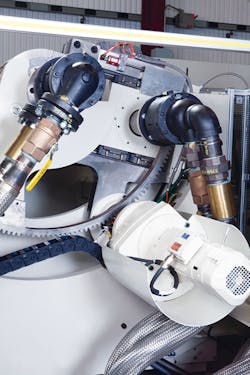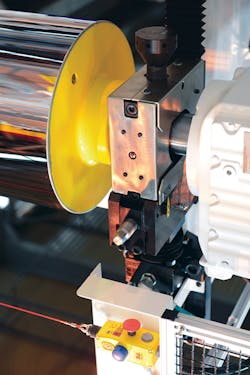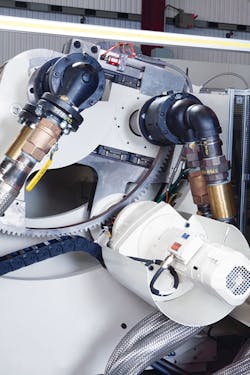Extruders adopt exacting standards to meet tough sheet requirements
The production of optical grade products, such as the screens and displays in computers and mobile devices, requires a focus on exacting standards. The specifications vary, according to the product and customer. Cleanliness in the manufacturing process is paramount.
Techplast Coated Products, Baldwin, N.Y., indicates some of the performance demands on optical grade products when it notes that its acrylic and PC sheet offerings boast scratch-, fog- and reflection-resistance. Its products include flat-panel screens, architectural models and instrument displays. Other products requiring optical grade features include greenhouses and small sheds.
WELEX
"Optical and graphic arts applications are more demanding of tight tolerances at every point on the line," says Mike Duff, director of business development for Welex, a unit of Graham Engineering Corp., York, Pa.
Graham Engineering recently custom-designed and built a Welex Evolution coextrusion line for high-end graphic applications. With a 4.5-inch main extruder and 2.5-inch coextruder, the line is designed to produce 55-inch-wide APET/PETG sheet with thicknesses of 0.010-0.040 inch at a rate of 1,200 pounds per hour. "From screw design to takeoff, each Welex sheet line is engineered to meet the customer's unique specifications," Duff says.
To achieve optical quality, Duff says the company puts consideration into every detail. "Beginning with the specifications, we evaluate the main and coextruders and the feedblock to achieve not only desired rate and layer structure, but also special surface modification via additives such as antistatic or ultraviolet protection that are common in these demanding applications. Beyond the die, critical considerations include roll design, tight thickness control and vibration-dampening to enable a defect-free finish, the hallmark of optical and graphic arts applications." With such high standards, Duff says sheet suppliers might need a variety of specialty features on their lines, such as automatic nip adjustment, roll skewing for thin-gauge accuracy, quick-change roll-removal options, anti-vibration water valves, closed-loop thickness profile and line-speed control, or a customized roll stand.
DAVIS-STANDARD TACKLES OPTICAL SHEET
Steve DeAngelis, VP of the sheet and foam group of Davis-Standard LLC, Pawcatuck, Conn., provides general recommendations for meeting optical sheet requirements. In the clean-room environments where optical grade sheet is made, the particulars of the extrusion process aren't the only considerations.
"Particulate matter, they measure it at the microscopic level, and any type of defects in the sheet, they reject it," DeAngelis says. This means that everything from resin-handling to rolling the sheet must be executed fastidiously. Resin must be filtered for dust and contaminants twice before processing. To obtain exceptionally low filtration levels of 3 microns, dual-bolt continuous screen changers and additional filtration equipment from Seebach GmbH, Vellmar, Germany, can be used. DeAngelis says a concern for cleanliness dictates the stringent filtering requirements. As he explains, "Would you want to see a dust particle on your LCD?"
Davis-Standard's general recommendations incorporate a special extruder for PC that has a 40-to-1 L/D ratio, air cooling, low-centerline screw and concrete-filled bases to minimize screw vibration. A die lip radius of 25-50 microns is preferred, compared to the standard radius of 150-200 microns.
The Davis-Standard recommendations call for an EverSharp die from Nordson Extrusion Dies Industries LLC, Chippewa Falls, Wis., which has a tungsten carbide coating. The coating lasts up to eight times longer than the standard chrome plating used for flat die lips.
Additionally, recommendations call for an orbital design roll stand with 130 degrees of rotation and a roll body with peripheral borehole design made of a special chromium alloy, hammer-forged steel. In this setup, the roll surface would be ground by stone and hard chrome-plated with an approximate thickness of 150 microns, then polished with a black gloss finish. The roll body must be almost perfectly cylindrical to a tolerance of 3 microns or less. The roll stand includes special high-tolerance bearings and planetary gearboxes.
Downstream, the requirements include a cooling conveyor with high-finish motorized and air/water-cooled idlers with surfaces coated with polytetrafluoroethylene; and dual-masking, double-pull roll stations. Tension controlled unwinders ensure good lamination. In addition, special saw blades for inline and traverse cutting are needed to control dust and fines, and stackers for gauges as thin as 0.5mm need to operate at relatively high speeds with low cycle times and minimum stroke lengths.
COPERION TECHNOLOGY OFFERS BOTH COMPOUNDING AND EXTRUSION FOR SHEET
Coperion Corp., Ramsey, N.J., manufactures co-rotating, fully intermeshing twin-screw compounding extruders that can produce the materials necessary for optical grade sheet, as well as tinted sheet. Eberhard Dieterich, manager of extruder sales, says the company's high-torque ZSK Mc18 compounder offers high throughput rates and operating flexibility. Its key features include the self-wiping of one screw with respect to the other and the possibility to directly incorporate additives, fillers and colors. This eliminates stagnation and potential degradation of material as it is transported and mixed along the length of the compounding extruder. This is especially important for PC sheet.
A variety of screw diameters is available with the ZSK Mc18, which has models varying in screw speeds and torque forces. Coperion says the series meets the requirements of a number of applications, and it is ideal for working with reinforced-fiber materials, volatile components and continuous processes that use high levels of energy.
The Coperion line can also be used in the direct-extrusion process, which brings together compounding and sheet extrusion, and eliminates the need for predrying. In this process, non-predried polymers, such as PC, polymethyl methacrylate (PMMA) or PET, are fed along with additives into a first barrel. There, they are melted and homogenized and volatiles are removed via the vacuum zone. The melt pump generates the pressure buildup for the screen pack changer and the die. The biggest benefit of using the ZSK Mc18 for direct extrusion is the outstanding mixing performance in the case of alloys, compared to other machine systems, Coperion says.
The line's high torque levels improve product quality and allow operators to achieve high throughputs. High torque and lower processing temperatures are especially beneficial in applications using PC, PMMA and PET.
Coperion says the use of the twin screw offers a number of advantages over using a single screw for sheet extrusion. They include the lack of need for predrying; quick color changes because of the possibility of self-cleaning; the direct incorporation of additives and colors; and good melting, homogeneity and mixing performance. Coperion also notes the twin-screw extruder's degassing capacity and lower energy consumption.
NEW ERA CONVERTING STRESSES CLEANLINESS
New Era Converting Machinery Inc., Paterson, N.J., emphasizes the importance of materials-handling considerations. The company makes a range of machines, including winders and unwinders, and web- and roll-handling equipment.
Executive VP Paul Lembo says optical sheet equipment needs to be built to clean-room standards, not only to prevent debris generated by the equipment from contaminating the process, but also so that the machinery can be easily cleaned and maintained. He says one of the most important requirements is to keep all moving components outside the equipment frames and under enclosures.
Lembo makes several additional recommendations for the process. When cutting optical quality products, either at the winder for making transfers or when slitting is required, the process should be isolated from the balance of the equipment through the use of ventilated enclosures as much as possible. In addition and where practical, web cleaners downstream of the operation should be incorporated to prevent debris from migrating to subsequent sections of the equipment.
Not to be overlooked is the importance of jumbo roll-handling once the material is offloaded from the winder. Automated systems for roll-handling limit operator interaction with the material, and the roll should be handled properly and wrapped, Lembo says.
Of critical importance in any optical sheet operation is active static control. A thorough review of the equipment line should be undertaken to identify any areas where static elimination bars should be incorporated. These reviews should be routinely repeated, to ensure proper static levels on the machine.
In addition, Lembo urges great care in the design and fabrication of web-conveyance rollers for the process. Poorly designed conveyances will not only introduce defects by scratching the web, but also lead to contamination.
The ability to keep the system clean is imperative. To lay the groundwork for a clean production environment, Lembo suggests using materials such as stainless steel or nickel-plated steel and avoiding flat surfaces, exposed fasteners and poor-quality welds.
Merle R. Snyder, senior correspondent
Contact:
Coperion Corp., 201-327-6300, www.coperion.com
Davis-Standard LLC, 860-599-1010, www.davis-standard.com
New Era Converting Machinery Inc., 201-670-4848, http://neweraconverting.com
Nordson Extrusion Dies Industries, 715-726-1201, www.nordsonpolymerprocessing.com
Seebach GmbH,
49-561-982-97-0, www.seebach.com
Welex, 215-542-8000, www.welex.com


